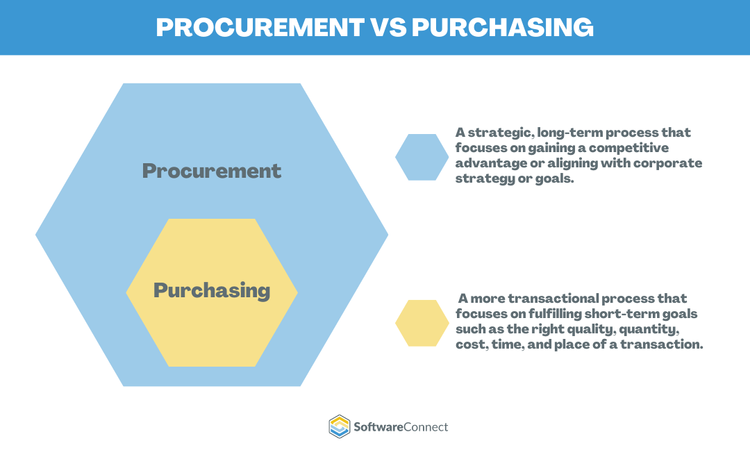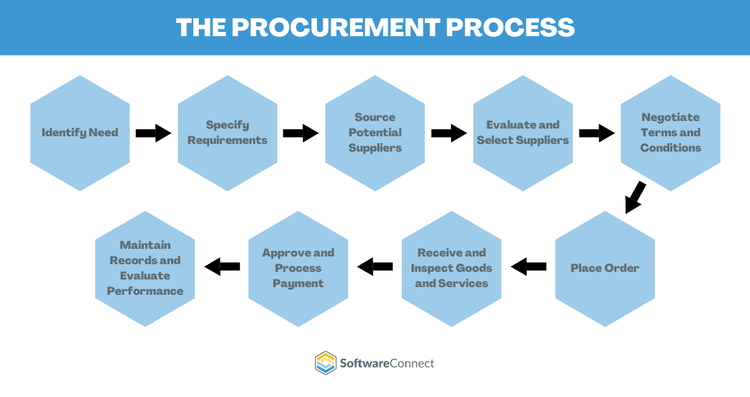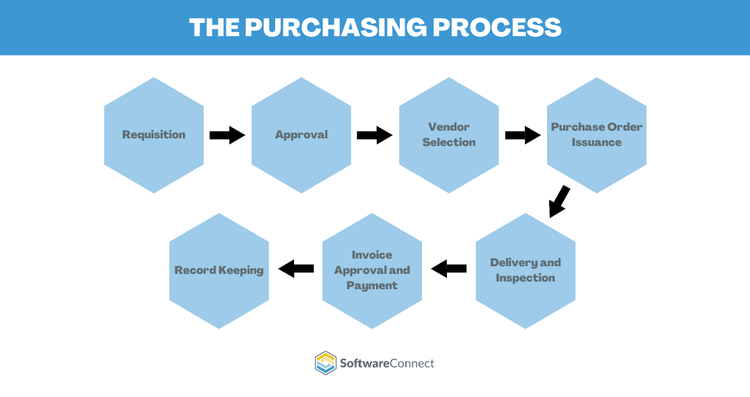Procurement vs. Purchasing: What’s the Difference?
Although procurement and purchasing are often confused, they are distinct processes. Procurement is a strategic, long-term approach aimed at gaining a competitive edge or aligning with corporate goals, while purchasing is a transactional process centered on fulfilling immediate needs.

What is Procurement?
Procurement is the process of acquiring goods, services, or works from an external source. It involves identifying the need for a product or service, selecting a supplier, negotiating terms and conditions, and managing the contract.
Procurement is a strategic process that aims to optimize value for money, minimize risk, and ensure quality and sustainability. It involves collaboration between different departments within an organization, such as finance, legal, and operations, as well as with external stakeholders, such as suppliers and customers.
Effective procurement can help organizations achieve strategic objectives, increase efficiency, and reduce costs.
Procurement software allows you to issue purchase orders (POs) for services and products by tracking all key order info in real-time including: the vendor, purchase quantities, item or service purchased, delivery timeframes, payment terms, and costs.
Example: A construction company needs cement for an upcoming project. They specify the quantity, quality, and delivery timeline, then source potential suppliers, issuing an RFQ.
After evaluating the received quotes based on price, quality, and delivery times, they select the most suitable supplier and negotiate the purchase terms. Upon delivery, they inspect the cement, approve the invoice, process payment, and maintain transaction records while also evaluating the supplier’s performance for future purchases.
The Procurement Process

The procurement process can vary depending on the organization and the nature of the items being procured, but generally, it involves the following steps:
- Identify the need: The first step is recognizing the need for a particular product or service. This need could be triggered by a business requirement, a stock shortage, or a customer request.
- Specify requirements: Once the need is identified, the next step is to define the product or service specifications. Specifications include details such as quantity, quality, delivery timelines, and other essential features or characteristics.
- Source potential suppliers: The company then needs to identify potential suppliers who can provide the desired goods or services. This could involve researching suppliers, asking for recommendations, or issuing a Request for Proposal (RFP) or Request for Quotation (RFQ).
- Evaluate and select suppliers: After potential suppliers have been identified, they are evaluated based on factors such as price, quality, reliability, and delivery times. The company then selects the most suitable supplier(s).
- Negotiate terms and conditions: The company negotiates the terms of the purchase, including price, payment terms, delivery timelines, and any other necessary details. This step may involve signing a contract.
- Place the order: Once terms are agreed upon, the company places the order with the selected supplier.
- Receive and inspect the goods or services: Upon delivery, the goods or services are inspected to ensure they meet the agreed-upon specifications.
- Approve and process payment: If the goods or services are satisfactory, the invoice is approved, and the payment is processed.
- Maintain records and evaluate performance: After the procurement process is complete, records are maintained for future reference. Supplier performance is also evaluated to inform future procurement decisions. This can involve monitoring delivery times, assessing product quality, or measuring overall supplier reliability.
The procurement process is a cyclical and ongoing process that helps businesses maintain a steady supply of the goods and services they need to operate effectively.
What is Purchasing?
Purchasing is the process of acquiring goods and services. Purchasing is a subset of procurement and involves creating purchase orders, ordering goods or services, arranging payment, and receiving.
Purchase order software helps create the financial document issued to vendors when you are buying supplies or services. Purchase orders typically include information such as product type, quantity, and pricing, along with other relevant data.
Example: A hospital’s medical department identifies the need for additional syringes and submits a purchase requisition detailing the required quantity and specifications.
The hospital director approves the requisition, and the purchasing department selects a reputable medical supply vendor based on pricing and past experience. Next, a purchase order is issued to the chosen vendor, specifying the syringe type, quantity, price, and delivery date.
Upon delivery, the hospital staff inspects the syringes to ensure they match the purchase order and are of satisfactory quality. The vendor’s invoice is then approved and paid, and all documentation is filed for future reference.
The Purchasing Process

The purchasing process is a subset of the overall procurement process and focuses on the transactional phase of procuring goods or services. Here are the general steps:
- Requisition: This is the initial step where a department or individual within the organization identifies a need for a product or service and submits a purchase requisition. This document details what is needed, the quantity, and often, the time frame in which it’s required.
- Approval: The purchase requisition is reviewed and approved by the appropriate authority, often a manager or director. This step ensures that the purchase is necessary and the budget is available.
- Vendor selection: The purchasing department identifies potential vendors based on the product or service to be purchased. The selection could be based on previous relationships, pricing, quality, service, or a formal bidding process.
- Purchase order issuance: A purchase order (PO) is created and sent to the selected vendor. The PO includes specific details like the type and quantity of products or services, prices, delivery date, and payment terms.
- Delivery and inspection: Once the goods or services are delivered, they are inspected against the purchase order to ensure the correct items were received, in the right quantity, and in good condition. In the case of services, they are checked against the service level agreement (SLA).
- Invoice approval and payment: After the goods or services have been received and approved, the vendor sends an invoice. The invoice is compared to the PO and the goods received. If everything matches, the invoice is approved for payment.
- Record keeping: All documents related to the purchase, including the requisition, PO, delivery note, and invoice, are recorded and filed for future reference and audits.
The purchasing process is a critical component of supply chain management and plays a significant role in controlling expenses, managing inventory, and ensuring the organization’s smooth operation.
Key Differences
| Difference | Procurement | Purchasing |
|---|---|---|
| Approach | A proactive approach that involves identifying needs and planning for the future. | A reactive approach that takes place when a specific need arises and needs to be quickly addressed. |
| Process | A flexible process that involves more strategic decision-making. | A standardized process that follows fixed steps of issuing POs, receiving goods, and processing payments. |
| Focus | The focus is relational, involving building and maintaining vendor relationships. | More transactional, focusing on specific transactions without considering ongoing relationships. |
| Risk | Involves risk mitigation and evaluation when evaluating supplier reliability and market volatility. | Does not involve risk mitigation steps. |
| Goals | Aims to establish long-term goals. | Fulfills short-germ goals, addressing immediate needs by acquiring specific goods/services. |
Using Software To Manage Procurement and Purchasing
Purchasing and procurement both fall under the procure-to-pay process. This encompasses the entire procurement lifecycle, from acquiring the goods to final payment. Using procure-to-pay software streamlines this process and can offer significant benefits:
1. Efficiency and Automation:
Software can automate many routine tasks involved in procurement and purchasing, such as generating purchase orders, tracking deliveries, and processing payments. This automation reduces manual work, speeds up processes, and minimizes the risk of human error.
2. Cost Savings:
Procurement software can help organizations identify areas of unnecessary spending by providing an overview of all purchases and contracts. The software can also help negotiate better terms with suppliers by providing historical data and analytics.
3. Improved Accuracy and Transparency:
Software solutions can provide real-time updates on the status of orders, deliveries, and payments, ensuring all stakeholders have access to accurate and up-to-date information. This transparency can improve decision-making and accountability.
4. Supplier Management:
Software can help manage relationships with suppliers, track their performance, and maintain all relevant information in one place. This can help organizations evaluate their suppliers more effectively and make informed decisions about future collaborations.
5. Compliance and Risk Management:
Procurement software can help organizations maintain compliance with internal policies and external regulations. It can also assist in identifying and managing potential risks, such as supplier reliability or contract disputes.
6. Data Analysis and Reporting:
With software, businesses can easily analyze their procurement and purchasing data, identify trends, and generate detailed reports. This can support strategic planning and help identify opportunities for improvement.
7. Scalability:
Procurement and purchasing software is scalable, meaning it can grow with your business. As the volume of your transactions increases, the software can handle the added complexity without additional resources.
By implementing procurement and purchasing software, businesses can streamline their operations, save costs, improve supplier relationships, and make data-driven decisions, leading to more effective and efficient procurement processes.
